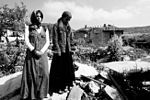
Back اضطرابات عام 2004 في كوسوفو Arabic Ausschreitungen im Kosovo 2004 German Kerusuhan di Kosovo 2004 ID コソボ暴動 (2004年) Japanese Zamieszki w Kosowie w 2004 roku Polish Distúrbios no Kosovo em 2004 Portuguese Revoltele din Kosovo din 2004 Romanian Беспорядки в Косове (2004) Russian Nemiri na Kosovu i Metohiji 2004. Serbo-Croatian Trazirat e vitit 2004 në Kosovë Albanian
| 2004 unrest in Kosovo March Pogrom | |||
|---|---|---|---|
Ruins of Serbian houses and Serbian Orthodox monasteries | |||
| Date | 17–18 March 2004 (1 day) | ||
| Location | |||
| Resulted in |
| ||
| Parties | |||
| Number | |||
| |||
| History of Kosovo |
|---|
 |
| History of Serbia |
|---|
 |
|
|
On 17–18 March 2004, violence erupted in Kosovo, leaving hundreds wounded and at least 19 people dead. The unrest was precipitated by unsubstantiated reports in the Kosovo Albanian media which claimed that three Kosovo Albanian boys had drowned after being chased into the Ibar River by a group of Kosovo Serbs. UN peacekeepers and NATO troops scrambled to contain a gun battle between Serbs and Albanians in the partitioned town of Mitrovica, Kosovo before the violence spread to other parts of Kosovo.[9] Kosovo Serb communities and cultural heritage were attacked by crowds of Albanians. Serbs call the event the March Pogrom (Serbian: Мартовски погром, romanized: Martovski pogrom),[10] while the Albanians call it the March Unrest (Albanian: Trazirat e marsit).
The violence resulted in the displacement of more than 4,000 Kosovo Serbs and other minorities. More than 935 houses, along with 35 Serbian Orthodox churches, monasteries and other religious buildings were destroyed. International and domestic courts in Pristina have prosecuted people who have taken part in the violence, including those who attacked several Serbian Orthodox churches, handing down prison sentences ranging from 21 months to 16 years.[11][12] Some of the destroyed churches have since been rebuilt by the Government of Kosovo in cooperation with the Serbian Orthodox Church and the UN mission in Kosovo.[13] The events led to protests in Serbia, and the burning of mosques in Belgrade and other places.[4][7]
- ^ Çollaku, Petrit (18 March 2015). "Deadly 2004 Unrest 'Damaged Kosovo's Image'". Balkan Insight.
- ^ "FM talks Kosovo at U.S. college". B92.net. 18 March 2011. Archived from the original on 24 June 2020.
- ^ "Culture and Cultural Heritage at the Council of Europe - Homepage - Culture and Cultural Heritage - www.coe.int". Culture and Cultural Heritage. Archived from the original on 2015-09-23. Retrieved 2023-05-27.
- ^ a b "Six years since March violence in Kosovo". B92. 17 March 2010. Archived from the original on 29 September 2015. Retrieved 7 September 2015.
- ^ "Kosovo: Protection and Conservation of a Multi-Ethnic Heritage in Danger" (PDF). UNESCO. April 2004. Archived (PDF) from the original on 2013-12-15. Retrieved 2018-02-23.
- ^ Ferrari, Professor Silvio; Benzo, Dr Andrea (2014). Between Cultural Diversity and Common Heritage: Legal and Religious Perspectives on the Sacred Places of the Mediterranean. Ashgate Publishing. ISBN 9781472426017.
- ^ a b Cite error: The named reference
bbc-no-evidencewas invoked but never defined (see the help page). - ^ "Commentary No. 87: The Status of Kosovo: Political and Security Implications for the Balkans and Europe". Archived from the original on 2012-12-17. Retrieved 2012-02-13.
- ^ "Fourteen dead as ethnic violence sweeps Kosovo". The Guardian. 18 March 2004. Archived from the original on 28 August 2013. Retrieved 17 March 2018.
- ^ The Government of the Republic of Serbia. "The March Pogrom (2004)". Archived from the original on 17 May 2020. Retrieved 9 December 2019.
- ^ "Four Years Later: Follow up of March 2004 Riots Cases before the Kosovo Criminal Justice System" (PDF). osce.org. July 2008. pp. 3–4, 23.
- ^ "Bitter Memories of Kosovo's Deadly March Riots". balkaninsight.com. 17 March 2015. Archived from the original on 4 October 2015. Retrieved 17 March 2018.
- ^ "Rindërtimi i kishave serbe në Kosovë pritet të përfundojë këtë vit" (in Albanian). Deutsche Welle. 17 March 2010. Archived from the original on 14 May 2020. Retrieved 9 February 2020.



